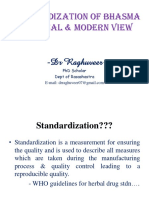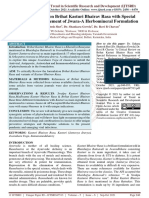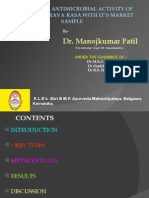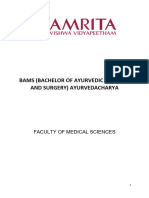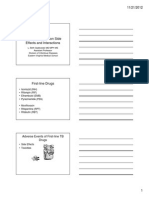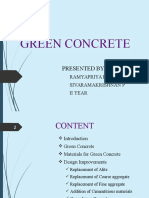Ayu332183-3146407 084424
Ayu332183-3146407 084424
Uploaded by
aurax143Copyright:
Available Formats
Ayu332183-3146407 084424
Ayu332183-3146407 084424
Uploaded by
aurax143Original Description:
Original Title
Copyright
Available Formats
Share this document
Did you find this document useful?
Is this content inappropriate?
Copyright:
Available Formats
Ayu332183-3146407 084424
Ayu332183-3146407 084424
Uploaded by
aurax143Copyright:
Available Formats
AYU | Apr-Jun 2012 | Vol 33 | Issue 2 183
Review Article
A critical study of Rasamritam and its applied aspects
Sudhaldev Mohapatra, Ramesh K. Gupta
1
, K. R. C. Reddy
2
, Chandra Bhushan Jha
3
Lecturer, Department of Rasa Shastra, Ayurvedic and Unani Tibbia College (Govt. of NCT), New Delhi,
1
Lecturer,
Government Ayurvedic College, Varanasi,
2
Reader,
3
Professor, Department of Rasa Shastra and Bhaishajya Kalpana,
Faculty of Ayurveda, Institute of Medical Sciences, Banaras Hindu University, Varanasi, Uattar Pradesh, India
Abstract
Historical studies of Rasa shastra reveal the use of metals and minerals, both for alchemical
and therapeutical purposes in ancient past. But, gradually the alchemical use of the subject,
declines and the therapeutical use takes over. Rasamritam is the latest doctrine in the eld
of Rasa shastra which compiles the extract of the older books and adopted some new and
contemporary concepts. The practical aspects of this text inuence both the academicians as
well as physicians in large extent. Keeping the wealthier, timely concept of this text in mind,
we are trying to review and analyze it critically for the benet of researchers and practitioners
and hope the idea will be fruitful.
Key words: Amritikarana, Dhatu, Dwigandhaayasa, Marana, Shodhana
Address for correspondence: Dr. Sudhaldev Mohapatra,
Lecturer, Department of Rasa Shastra,
Ayurvedic and Unani Tibbia College (Govt. of NCT),
Karol Bagh, New Delhi, 110005, India.
E-mail: ras_dev@rediffmail.com.
Introduction
Rasa Shastra deals with the knowledge of Parada and other
matters pertinent to it, along with the manufacturing of
medicines from metal/mineral, animal and some poisonous
herbal sources. From the period of Nagarjuna (7
th
AD), both
the alchemical and therapeutical use of the Rasa Dravyas were
carried out by the Rasa Siddhas and Rasa Vaidyas. Due to the
increase of diseases, advancement of science and decreasing of
classical knowledge and sufficient practical textual references
for alchemical methodologies and techniques, the therapeutic
use of Rasa Dravyas dominates over it. The text Rasamritam is
full of practical therapeutic use of different Rasa Dravyas and
their processing techniques. In Rasamritam the classification of
the drugs their descriptions, are presented in a very systematic
way, instead of following the traditional method. The division
of chapters are very much ideal. Description of indices with
practical applicability at the end of the book is the magnitude
of this text.
Authors recognition
Vd. Yadavji Trikamji Acharya was born on 1881 at Porbandar
in Gujarat, has contributed to Ayurveda in general and Rasa
Shastra in particular by writing and editing many books and
manuscripts like Rasamritam. Simultaneously he was a well
known physician, academician and administrator. He authored
AYU
Access this article online
Website: www.ayujournal.org
DOI: 10.4103/0974-8520.105235
Quick Response Code:
the text Rasamritam, on 1951 which was published by Motilal
Banarasi Das in Nirnaya Sagar Press, Kolbhat Street, Bombay.
After a very fruitful and far-fetched life he met the super soul
on 1956.
[1]
Vd. Yadavji Trikamji was one of the pioneers of Ayurveda. He
was one of the most helping hands to Dr. P. N. Mehta who
founded Gujrat Ayurveda University. Acharya Yadavji served
Gulabakunvarba Ayurveda Mahavidyalaya as teacher, consultant
and principal. He helped Vd. Hari Prapana Sharma for compiling
Rasa Yoga Sagara. He also edited and published Madhukosha
Vyaksha of Acharya Madhava, and Ayurveda Deepika of Acharya
Chakrapani. In the series of Ayurvediya Granthamala he has
edited and republished many books like Ayurveda Prakash, Rasa
Prakash Sudhakar, Rasa Kamdhenu, Rasa Sanketa Kalika, etc.
As an organizer, administrator, he chaired the Nikhila Ayurveda
Mahasamhelana at Haridwar (1925), Gwalior (1932), Delhi
(1950) and again in Haridwar (1953), He authored Dravyaguna
Vigyana, Ayurvediya Vyadhi Vigyana.
[2,3]
Subject matter of Rasamritam at a glance
This book consists of total 09 chapters and 09 indices.
As Parada is a central element of whole Rasa Shastra, it
is described as first chapter followed by Gandhaka in a
separate chapter.
All the Dhatus (metals) like Swarna, Rajata, etc.
are described along with Khanija (minerals) of the
corresponding Dhatu like Makshika for Tamra, Abhraka for
Loha etc. and Mishra Dhatus like Pitala, Kansya, etc. in a
same chapter under the name Loha Vigyaniya.
Drugs of Malla, Sudha, Sikta, Lavana, Kshara, Ratna are
discussed in individual chapters. The last chapter consists
of some compound formulations of therapeutic interest.
At the end precious information and instructions are given
[Downloadedfreefromhttp://www.ayujournal.orgonSaturday,April12,2014,IP:103.226.187.42]||ClickheretodownloadfreeAndroidapplicationforthisjournal
184 AYU | Apr-Jun 2012 | Vol 33 | Issue 2
Mohapatra, et al.: Critical study of Rasamritam
regarding different pharmaceutical and clinical aspects in
09 indices.
Information regarding Puta and preparation of Bhasma is
given in 1
st
index. 2
nd
and 3
rd
indices consist of description
of Chapala and Shilajatu.
In 4
th
index special discussion on Makshika and Vimala is
described. Authors own view on Rasaanjana is given in 5
th
index.
6
th
and 7
th
indices are the collection of adverse and toxic
effects of Rasa Dravyas and mineral materials from which
Satva can be extracted.
Shodhana method of some plant materials frequently used in
preparation of different compound formulations are given in 8
th
index. 9
th
index consists of the list of references from Charaka
and Sushruta Samhita, where Rasa Dravyas are described.
[4,5]
Analysis of Dehavada and Dhatuvada on Rasamrita
Rasamritam is massively enriched with the descriptions
of Dehavada (transforming the sick body to healthier one
through Rasaoushadhies).
In the first chapter only 08 Sanskaras of Parada are given
which indicates its use for Dehavada.
[6,7]
Description of Gandhaka in a separate chapter, after Parada
possibly facilitates the Dehavada motto of the author.
No description of Abhraka, chief material for Dhatuvada
[8]
as a separate chapter shows the less importance of Abhraka
in comparison to Gandhaka in this particular text.
Other materials like Makshika, Rasaka, Chapala, etc. are
described in the line of Dehavada.
Description of pharmaceutical processings like Shodhana
and Marana (no any alchemical processings like Charana,
Ranjana, etc.) in different chapters for specific materials
followed by their therapeutic use strengthens the Dehavada
idea of the book.
Special discussion on Puta and Bhasma in the indices
indicates the dominance of Dehavada over Dhatuvada.
In the last chapter description of 66 Rasaoushadhies
and no description of any method regarding Dhatuvada
(alchemical processings) anywhere in the book, clears the
concept that the book is a dominating book of Dehavada.
Chapter Discussion
I
st
chapter (Parada Vigyaniya)
Description of Naisargika and Yaogika Dosas, name,
definition and procedures for 08 Sanskaras and strict
indication for use of Parada in Rasayogas only after 08
Sanskara.
Serial description of Kajjali, Rasa Parpati, Rasasindura,
Makaradhvaja, Mallasindura, Rasa Karpura shows the
systematic way of presentation of the Rasayogas according
to the Agni Mana, difficulty in processings and safety in
preparations.
Claim for Nischandratva of Kajjali is found in this text.
Shodhana process of Parada (in Jayanti Bhringaraja,
Eranda, Kakamachi Swarasa) and Gandhaka (in
Bhringaraja, Swarasa, both Bhavana and Dhalana) are
described in the context of Rasa Parpati.
Hingula and Girisindura are described as minerals of
Parada.
Properties of Hingula, its Shodhana (through Bhavana
in sheep milk and lemon juice) and Darada Vati are
described.
2
nd
chapter (Gandhaka Vigyaniya)
Shodhana (in milk and Bhringaraja Swarasa) and properties
of Gandhaka are described along with Gandhaka Rasayana
Chaturjataka, Triphala, Bhringaraja, Guduchi, Adraka (10
drugs) 08 Bhavana of each separately}.
3
rd
chapter (Loha Vigyaniya)
Swarna, Rajata, Tamra, Pittala, Kansya, Makshika, Tutha,
Jangara, Vanga, Naga, Mridarasringa, Souviranjana, Yasada,
Puspanjana, Rasaka, Loha, Mandura, Vimala, Kasisa,
Gairika, Abhraka, Ayaskanta are described with respect to
their synonyms, properties, Shodhana and Marana where
ever necessary. Corresponding alloys and minerals are
described immediately after the main metal.
This book is influenced by the modern chemistry as
HCL, H
2
SO
4
, HNO
3
, Oxalic acid are used for different
pharmaceutical processings e.g Shodhana and Marana of
Swarna.
In the context of Tamra Visehsa Shodhana {Arka Kshira +
Saindhava (Lepana), Nirgundi Swarasa (Nirvapa) or cows
urine (Swedana)}, Amritikarana (with Surana Kanda), and
Dosha are described.
For the preparation of Tamra Bhasma at first Patana
technique is used, to get partially prepared Bhasma, and
then Puta system of heating is followed to get the final
Bhasma.
Nilakantha Rasa, Tuthadrava and Tutha Malahara are
described in context of Tutha.
Jangara is a unique preparation, which is prepared from
Tamra. When the curd is kept in a copper vessel for
certain duration till all the moisture content evaporate, the
greenish material thus obtained is known as Jangara and is
used for Dushta Vrana Shodhana and Vrana Ropana.
Vishesa Shodhana (Haridra and Nirgundi) of Vanga,
preparation of Swrana Vanga is described in context of
Vanga.
Swayamagni Loha Bhasma and Ayaskriti are described in
context of Loha. (heating and quenching in Triphala and
Salasaradi Gana for 16 times).
03 types of Loha are described like Munda, Tikshna and
Kanta, these are superior in quality succeedingly.
The specific feature for Kasisa Bhasma i.e. Niramla is
found in this text.
Gill Armani and Gill Makhtum like Unani medicines
are also described in continuation of Gairika and are
considered as types of Gairika.
4
th
chapter (MallaVigyaniya)
Shodhana procedure and properties of Gouripasana,
Haritala and Manahshila are described.
In the context of Gouripasana Mallavati {Rasa sindura
(01), Guduchi Satva (100)} and Phenasma Drava, in
context of Haritala Talasindura and Rasa Manikya and in
context of Manasila, Silasindura are described.
5
th
and 6
th
chapter (Sudha and Sikata Vigyaniya)
Churnodaka, Khatikadi Churna, Godanti Bhasma and
Kasisa Godanti Bhasma {Shudha Kasisa and Shudha
[Downloadedfreefromhttp://www.ayujournal.orgonSaturday,April12,2014,IP:103.226.187.42]||ClickheretodownloadfreeAndroidapplicationforthisjournal
AYU | Apr-Jun 2012 | Vol 33 | Issue 2 185
Mohapatra, et al.: Critical study of Rasamritam
Godanti + Kumari-(Gajaputa)} are described in Sudha
Varaga where as Dugdha Pashana, Naga Pashana and
Hajral Yahud, are described in Sikata Varga with their use.
7
th
chapter (Lavana and Kshara Vigyaniya)
Properties and therapeutic indications of Saindhava,
Samudra, Romaka, Vida, Sauvarchala, Oudbhida are
described.
In context of Kshara Varga Yava Kshara, Saji Kshara, and
Tankana Kshara are described along with Sphatika and
Karpura Shilajatu.
Ela Hima is used for Shodhana of Karpura Shilajatu.
8
th
chapter (Ratna Vigyaniya)
About 07 Ratnas i.e Manikya, Neelam, Pusparaga, Gomeda,
Vaidurya, Tarkshya, Vajra are described by their Shodhana
procedure and properties. Marana procedures of Ratnas
are described in general.
09 Uparatnas i.e Rajavarta, Sangayesava, Akika, Sphatika,
Suryakanta, Chandrakanta, Piroja, Vaikranta and Kaharuva
are described. Parada is used to make the Vajra powder.
9
th
chapter
In this chapter the author has described 66 Rasa Yogas
which include Kharaliya, Parpati Rasa and Pottali Rasa.
Only one Asava i.e Lohaasava is included.
Indices
1
st
index. (Information regarding Bhasma and Puta)
Regarding the Bhasmikarana the author has the following views:
At first the material to be incinerated should be subjected
for Shodhana and specific Shodhana procedures where
applicable, then powdered. Associated minerals (Haritala,
Manahshila, Hingula, etc.) are added and pounded followed
by addition of liquid media prescribed for particular
material then subjected for bhavana at least 10-12 h.
Pellets should be flat rather than rounded, it should be
completely dry before keeping into Sharava, one pellet
should be in between 1-2 Tola.
He emphasized on sealing of the joint of samputa to
facilitate more time of contact of main material with
associated materials like Gandhaka, Parada Manshila, as
these are volatile in nature. Also due to toxic nature of
these vapours.
He suggested not sealing of the joint where the associated
materials like Parada and Gandhaka are not added,
particularly, in last 2-3 puta, to facilitate direct contact of
fire and oxygen to the material to be incinerated.
He suggested that during the arrangement of pellets in
the casseroles not more than two layers should be kept, to
facilitate equal distribution of temp to all pellets.
The casseroles used for Samputa should not have more
depth to allow less space in between the Samputa.
In case of Abhraka, Loha, Mandura, Tamra and Makshika
initial Putas should be given in more fire and later on fire
should be lowered.
For Suvarana, Rajata, and Naga the initial putas should be
given in less fire and later on fire should be increased.
2
nd
and 3
rd
indices
4 types of Chapala i.e whitish, blackish, greenish, and
reddish are described and said that it melts like Vanga
hence called Chapala. It causes Rasa Bandha.
Properties of Shilajatu along with its formation and
Grahya Lakshana, Shodhana procedure of Shilajatu in
the technique of Agnitapi and Surya Tapi and features of
Shudha Shilajatu are described (in parameters of smell,
taste and solubility). Different Anupana of Shilajatu are
also indicated like Dugdha, Takra, Mamsa Rasa, Salasaradi
Gana Kashaya etc.
4
th
index
Historical approach of Makshika from Samhitas.
Two types i.e Kanchnabhasa - Madhura and Rajatasannibha
Amla are described
The author identified that the material having one iron
and two sulphur molecule and having features like- with
angles, six surfaces, and brassy in color is Vimala. Its yellow
variety is not-reacted with air and white variety reacts
with air to form Kasisa and sulphuric acid. He called it
Dwigandhayasa.
According two author Makshika is the conversion of
Vimala. Two types of Makshika are described 1
st
one
is bronzy yellow, having same composition as Vimala
but presents with different shape and features (neither
specified nor named). 2
nd
type contains 02 molecule of
copper and Iron and 01 molecule of sulphur, an extra
element and is known as Suvarna Makshika.
5
th
index
Author differentiates Rasaanjana and Rasauta and claimed
that Rasanjana described in Rasa text should never be the
Rasakriya of Daruharidra it may be Rasauta.
As the synonyms of Rasanjana are Rasagarbha, Rasotbhava
which indicates its formation from Parada and it may
be yellow oxide of mercury. He quoted comments of
Dr. Vamana ganesha Desai and Dr. D.A Kulkarni.
6
th
index
Adverse effects caused by the intake of Ashudha Loha and
Dhatu Bhasma [Table 1].
7
th
index
Satvapatana of different Dhatus like Abhraka, Rajavarta,
Makshika, Vimala, Shilajatu, Tala, Manahshila, Sasyaka,
Chapala, Gouripashana, Hingula, Tuvari, Kasisa, Kharpara,
Anjana, Bhunaga, Vaikranta are described.
Associated materials used for Satvapatana are Tankana,
Ghrita, Pancha Gavya, Gunja, Madhu, Kshara and Amla,
Guda, Guggulu, Sajji Kshara, Yava Kshara, etc. and
Bhavana drugs used are Nimbu Swarasa, Kanji, Kulatha
Kwatha, Dugdha, Surana Swarasa.
8
th
index
Shodhana procedure of some herbal poisonous drugs i.e
Vatsanabha, Ahiphena, Dhatura Beeja, Jayapala, Gunja,
Kupilu, Bhallataka, Bhanga.
9
th
index
Descriptions of about 90 materials refereed from different
Samhitas, which are frequently used in different context of
Rasa Shastra.
[4-6]
[Downloadedfreefromhttp://www.ayujournal.orgonSaturday,April12,2014,IP:103.226.187.42]||ClickheretodownloadfreeAndroidapplicationforthisjournal
186 AYU | Apr-Jun 2012 | Vol 33 | Issue 2
Mohapatra, et al.: Critical study of Rasamritam
Table 1: The adverse effect caused by the intake of
Ashudha Loha and Dhatu Bhasma
Metal Dosa
Rajata Santapa, constipation, loss of strength and vigour
Vanga,
Yasada
Prameha, Gulama, Hridaya Roga, Shula, Arsha,
Kasa, Shvasa, vamana
Naga Prameha, Kshya, Kamala, Gulama, Shula,
Bhagandar
Loha Ama, loss of appetite, Gulma, diarrhoea, Shotha
Gandhaka Santapa, Kushtha, Bhrama, and loss of strength
Hingula blindness, Bhrama, Murcha, Prameha, malease
Abhraka Kushtha, Kshaya, Shotha, Parshva Shula
Tala Prameha, Santapa, stiffness, increases Vata and
Pita
Kharpara Vamana, Bhrama
Manashila Ashmari, Mutrakrichra, constipation,
Tankana,
Tutha
Vamana, Bhrama
Shilajatu Daha, Murchha, Bhrama, blood Diseases,
constipation
Vajra Parshva Shula, nausea, Daha
Practical aspects of Rasamritam
The book is compiled with the aim to overcome
the controversies regarding both in academics and
pharmaceutical point of view.
Author has not classified the raw material as like Maharasa,
Uparasa, Sadharana Rasa, etc. he started with Parada the
most important material followed by Gandhaka second
most so far as Dehavada is concerned. Then metal and
followed by the minerals and compounds of that particular
metal. This rather looks systemic.
Too many pharmaceutical techniques for the processings
of metals and minerals are described by the use of many
associated materials (like Bhavana Dravya, Marana Dravya,
etc.) in available literatures. But the author tried to
describe only those methods which are easier and could be
performed practically with available associated materials.
The author has clear view regarding the sanskara i.e only
08 Sanskara is described with a single procedure for each
which could be performed practically. For therapeutic
purposes.
Regarding Puta and Bhasma very practical approach is
described in 1
st
index i.e about pellets, sealing of joint
firing technique for different materials etc.
Description of Shodhana of some herbal poisons drugs are
very much practical and expressed in simplest way.
Description of adverse effect of the mateials which
are either taken in Ashudha condition or in improper
Marita (Bhasmikarana) condition in one place makes the
clinicians easy to access the patient who take a compound
formulation.
Description of around 66 important formulations helps the
clinicians practically as these are less easy to manufacture
and administer.
Demerits of the text
No description of Paribhasha is available, which is a lacuna of
this book.
Description of Dhanyabhraka and Amritikarana are not found
in context of Abhraka.
Conclusion
Very systematic classifications of materials are found in
this text.
The book is mainly based on Dehavada and hardly any
description of Dhatuvada is found.
The description of 09 indices at the end, are most valuable
part of this book which describes the practical utility of
manufacturing processes of Rasa Dravyas.
It is a literature of modern era where amalgamation
of modern chemistry and Rasa Shastra occurs. Also
incorporation of some Unani drugs are found.
List of references of materials from Charaka and Sushruta
are found in one place.
All most all materials are described in very brief manner
and unnecessary, practically unusable methods are not
discussed.
The book could prove beneficial for an academician as
well as the practitioners who are preparing medicine for
their own patients particularly for Rasa Vaidyas.
References
1. Sharma PV. Ayurveda ka Vaigyanika Itihasa, Chapte 05. 9
th
ed. Varanasi:
Chaukhamba Orientalia; 2007. p. 425,488.
2. Shukla Vidyadhar and Tripathi Ravidatta, Ayurved ka Itihas Evam Parichaya.
Chapter - 09, Reprint. New Delhi: Chaukhamba, Samskrit Pratisthan
2005. p. 189-90.
3. Jha CB. Ayurvediya Rasa Shasta. Reprint, Chaukhamba Surabharati,
Varanasi, 2006 p-56.
4. Vd. Yadavji Trikamji Acharya, Rasamritam. Banarasa: Motilal Banarasi
Das; 1951.
5. Joshi D. Rasamritam, English Commentary 2
nd
ed. Varanasi: Chaukhamba,
Sanskrit bhavana; 2003.
6. Acharya Vagbhatt, Rasa Ratna Samuchchhaya. In: Sri Dattatreya Ananta
Kulkarni, editors. Chapter-11, verse- 58. New Delhi: ML Publication; 1969.
7. Upadhyay Madhav, Ayruveda Prakasha. edited by Gulraj Sharma and
Mishra, reprint, chapter-1, verse-36. Varanasi: Chaukhamba Bharti
Academy; 1999.
8. Bhagwat Sri Govinda Padacharya, Rasa Hridaya Tantra edited by
Chaturbhuja Mishra. 2
nd
ed. chapter-4, verse- 15. Kalorda, Ajmer: Krishna
Gopal Ayurveda Bhavan; 2002.
[Downloadedfreefromhttp://www.ayujournal.orgonSaturday,April12,2014,IP:103.226.187.42]||ClickheretodownloadfreeAndroidapplicationforthisjournal
AYU | Apr-Jun 2012 | Vol 33 | Issue 2 187
Mohapatra, et al.: Critical study of Rasamritam
l - ii
i i i il l i
a i ix, . i, . i. . , - i
i i l i l i i l i i l ia a i l i i
i i l i i i l l l i l i l , l i- i ii l l l a il i
l l i a i i i i l i i i l i l i i i i i i
la i i - i i i i i i i l i o i i i i i
l a i i l i i i l l i i l i i il i
l l i i i i i l i a i l i i l i l i i ,
i i l l l i i l l i i i i il i i i i i l i i
[Downloadedfreefromhttp://www.ayujournal.orgonSaturday,April12,2014,IP:103.226.187.42]||ClickheretodownloadfreeAndroidapplicationforthisjournal
You might also like
- MAHANYASAM Sanskrit RameshNatarajan GRD IyersDocument39 pagesMAHANYASAM Sanskrit RameshNatarajan GRD IyersSantosh Gupta100% (5)
- Encyclopedia of Astrological Remedies by Arun Kumar BansalDocument311 pagesEncyclopedia of Astrological Remedies by Arun Kumar Bansalaurax14382% (11)
- Anatomy RecallDocument337 pagesAnatomy Recallaurax14367% (9)
- Of Andhra Region Written in Classical Telugu VersesDocument7 pagesOf Andhra Region Written in Classical Telugu VersessillypoloNo ratings yet
- GandhagamDocument6 pagesGandhagamKeith BoltonNo ratings yet
- A Review On Rasamanjari: It's Contribution in Pharmaceutical ScienceDocument3 pagesA Review On Rasamanjari: It's Contribution in Pharmaceutical ScienceEditor IJTSRDNo ratings yet
- Overview On Ayurveda Prakasha - A Text of PDFDocument8 pagesOverview On Ayurveda Prakasha - A Text of PDFBhavana GangurdeNo ratings yet
- A Critical Review On Historical Aspects of KsharaDocument7 pagesA Critical Review On Historical Aspects of KsharaRaghuram KurojuNo ratings yet
- STDN of Bhasma Classical & Modern ViewDocument42 pagesSTDN of Bhasma Classical & Modern ViewMeenakshi ParimiNo ratings yet
- Drug Review SaptaparnaDocument28 pagesDrug Review SaptaparnaSam SamayaNo ratings yet
- Sapta Kanchuka Dosha1Document24 pagesSapta Kanchuka Dosha1DrVikas100% (2)
- Darshana Ichhabhedi Ras Jan 2018Document4 pagesDarshana Ichhabhedi Ras Jan 2018Mujahid KhanNo ratings yet
- YantraDocument32 pagesYantraLysDuRetyNo ratings yet
- Research A Clinical Study of Kankayan Vati in The Management of Arshas-Ayur ResearchDocument5 pagesResearch A Clinical Study of Kankayan Vati in The Management of Arshas-Ayur ResearchDrHassan Ahmed ShaikhNo ratings yet
- Kankushtha PDFDocument2 pagesKankushtha PDFVaidya Nur100% (1)
- Importance of Paryayas in Plant IdentificationDocument22 pagesImportance of Paryayas in Plant IdentificationSatish GuptaNo ratings yet
- Abhinava ChintamaniDocument7 pagesAbhinava ChintamaniBrad Yantzer50% (2)
- Role of Samskara in Safety of Rasadravyas - An OverviewDocument9 pagesRole of Samskara in Safety of Rasadravyas - An OverviewDrVikas100% (1)
- Physico-Chemical Evaluation of RasakarpuraDocument14 pagesPhysico-Chemical Evaluation of RasakarpuraDrVikasNo ratings yet
- KanjiDocument9 pagesKanjisankar kaliaperumalNo ratings yet
- A Critical Review On Brihat Kasturi Bhairav Rasa With Special Reference in Management of Jwara A Herbomineral FormulationDocument8 pagesA Critical Review On Brihat Kasturi Bhairav Rasa With Special Reference in Management of Jwara A Herbomineral FormulationEditor IJTSRDNo ratings yet
- Pravala - An OverviewDocument9 pagesPravala - An OverviewAcharya PrasannNo ratings yet
- Hima and Phanta KalpanaDocument6 pagesHima and Phanta KalpanaNaveenNo ratings yet
- Rewiew Study of VadamargDocument10 pagesRewiew Study of Vadamargkonic singh chauhanNo ratings yet
- Review On External Medicines in Siddha System of MedicineDocument10 pagesReview On External Medicines in Siddha System of MedicineCuriosityShopNo ratings yet
- 10.single Drug Therapy in Ardhavabhedaka With Special Reference To Migraine - A Review PDFDocument5 pages10.single Drug Therapy in Ardhavabhedaka With Special Reference To Migraine - A Review PDFk2kkhanna105No ratings yet
- Dravyaguna THU1Document21 pagesDravyaguna THU1Gursimran0% (1)
- Anandabhairava RasaDocument18 pagesAnandabhairava RasaDrVikasNo ratings yet
- Mrutyunjay Rasa: by DR - Vikas SarochDocument23 pagesMrutyunjay Rasa: by DR - Vikas SarochDrVikas0% (1)
- KSHETRIKARANAMDocument37 pagesKSHETRIKARANAMKarthika Jayan100% (1)
- GuduchiDocument28 pagesGuduchiBAMS doctorsNo ratings yet
- Gudapaka KalpanaDocument8 pagesGudapaka KalpanashreerangayurvedNo ratings yet
- KatukiDocument21 pagesKatukiShantu ShirurmathNo ratings yet
- Review On Druti Kalpana With Special Reference To.10Document4 pagesReview On Druti Kalpana With Special Reference To.10Hinal AmbasanaNo ratings yet
- Avaleha Kalpana (MedicatedDocument9 pagesAvaleha Kalpana (MedicatedAnonymous pqtS3tcu1No ratings yet
- Kadali Patradana in Dusta Vrana A Single Case StudyDocument3 pagesKadali Patradana in Dusta Vrana A Single Case StudyResearch ParkNo ratings yet
- Therapeutic Formulations of Nasya in Charak SamhitaDocument7 pagesTherapeutic Formulations of Nasya in Charak SamhitacantuscantusNo ratings yet
- Fundamentals of RasashastraDocument1 pageFundamentals of RasashastraprabhatNo ratings yet
- Mana Paribhasha LectureDocument31 pagesMana Paribhasha LectureshreerangayurvedNo ratings yet
- KSR RS BZAp1Document41 pagesKSR RS BZAp1ksr prasadNo ratings yet
- Clinical Application of Shadvidhopkrama A CriticalDocument6 pagesClinical Application of Shadvidhopkrama A CriticalBhonsle AmayNo ratings yet
- Mercurial, Metallic and Mineral PrparationsDocument6 pagesMercurial, Metallic and Mineral PrparationschakreeNo ratings yet
- Ayurvedic Pharmaceutics and Insights OnDocument40 pagesAyurvedic Pharmaceutics and Insights OnBhavana GangurdeNo ratings yet
- BhaishajyaDocument28 pagesBhaishajyadrsa2No ratings yet
- Ayurvedic Concept of Rasayan TherapyDocument14 pagesAyurvedic Concept of Rasayan TherapyKanjarla Hanmonthrao Panthulu Laxmana100% (1)
- Amalaki MahotsavaDocument15 pagesAmalaki MahotsavabhapkarsaaksshiNo ratings yet
- Bams Curriculum 1Document100 pagesBams Curriculum 1Sandeep Singh100% (1)
- Practical Apporoach To UttarbastiDocument19 pagesPractical Apporoach To UttarbastiMadhura PhadtareNo ratings yet
- 9 Roga-Nidana PDFDocument2 pages9 Roga-Nidana PDFGuna Soundari60% (5)
- Hikka Nigrahana Mahakashaya-A Critical Review: Dr. Suman Shakya Dr. Manohar Ram Dr. Ramnihor Tapsi JaiswalDocument7 pagesHikka Nigrahana Mahakashaya-A Critical Review: Dr. Suman Shakya Dr. Manohar Ram Dr. Ramnihor Tapsi Jaiswalrotinaan86No ratings yet
- Sharkar KalpanaDocument7 pagesSharkar KalpanashreerangayurvedNo ratings yet
- Chandra Kala RasDocument64 pagesChandra Kala RasAnurag DixitNo ratings yet
- Pharmaceutico-Analytical Study of DadimavalehaDocument8 pagesPharmaceutico-Analytical Study of DadimavalehaIJAR JOURNALNo ratings yet
- Syllabus of RSBKDocument105 pagesSyllabus of RSBKfarhan akhtarNo ratings yet
- Rasa Shastra NamingsDocument9 pagesRasa Shastra NamingsKesavanadh T MNo ratings yet
- Formulation Seminar: Yogaraj GugguluDocument22 pagesFormulation Seminar: Yogaraj GugguluDrVikasNo ratings yet
- Parad Purification PDFDocument9 pagesParad Purification PDFrajeshNo ratings yet
- Pharmaceutical Study of Pottali Kaplana: Vd.V.RamakrishnaDocument16 pagesPharmaceutical Study of Pottali Kaplana: Vd.V.RamakrishnaRamakrishna Viswanadha67% (3)
- Avleha KalpanaDocument14 pagesAvleha KalpanashreerangayurvedNo ratings yet
- The Science of Ayurveda: The Ancient System to Unleash Your Body's Natural Healing PowerFrom EverandThe Science of Ayurveda: The Ancient System to Unleash Your Body's Natural Healing PowerNo ratings yet
- An Ayurveda Treatise: Rasarnava: February 2018Document4 pagesAn Ayurveda Treatise: Rasarnava: February 2018Lokesh PatilNo ratings yet
- Rasamanjari: June 2021Document4 pagesRasamanjari: June 202153 Mulherkar MandarNo ratings yet
- Books On AyurvedaDocument29 pagesBooks On AyurvedaVenkat Rao50% (2)
- Article Wjpps 1430824043Document9 pagesArticle Wjpps 1430824043aurax143No ratings yet
- Dosha VigyanDocument46 pagesDosha Vigyannareshary75% (4)
- Tritiya SthanamDocument220 pagesTritiya Sthanamven_bams5840No ratings yet
- Pathyaapathya (Dos and Donts) Ayurvedic Advocacy On Conducive Diet and LifDocument57 pagesPathyaapathya (Dos and Donts) Ayurvedic Advocacy On Conducive Diet and Lifaurax143100% (1)
- Mudras For MeditationDocument14 pagesMudras For Meditationdeepul_s100% (4)
- TheMadhavaNidanaOfSriMadhavakara1943 TextDocument331 pagesTheMadhavaNidanaOfSriMadhavakara1943 Textaurax14350% (2)
- Vakeri BhateDocument9 pagesVakeri Bhateaurax143No ratings yet
- A Swami Practice of AyurvedaDocument283 pagesA Swami Practice of Ayurvedaivahdam100% (2)
- Formulae NotesDocument58 pagesFormulae Notesaurax143No ratings yet
- Maitrayaniya AranyakaDocument31 pagesMaitrayaniya Aranyakaaurax143No ratings yet
- 1 A Taoteching PDFDocument46 pages1 A Taoteching PDFaurax143No ratings yet
- Lakshmi Homam Sans Quick RefDocument9 pagesLakshmi Homam Sans Quick Refaurax143No ratings yet
- The Case of Incurable Eczema: First ChapterDocument105 pagesThe Case of Incurable Eczema: First Chapterjaved.alam19100% (8)
- TB Drugs: Common Side Effects and InteractionsDocument15 pagesTB Drugs: Common Side Effects and Interactionsaurax143No ratings yet
- Hiroshi Motoyama - Theories of The ChakrasDocument287 pagesHiroshi Motoyama - Theories of The Chakrasvinylfire413098% (42)
- Puran AsDocument683 pagesPuran Asmasmakkin6170No ratings yet
- PsoriasisDocument0 pagesPsoriasisaurax143No ratings yet
- Appendix 3264Document149 pagesAppendix 3264Sebastián MorenoNo ratings yet
- Maxwell's Equations - Simple English Wikipedia, The Free EncyclopediaDocument6 pagesMaxwell's Equations - Simple English Wikipedia, The Free EncyclopediaBruinNo ratings yet
- Flap Gate Headloss PDFDocument8 pagesFlap Gate Headloss PDFsudarsancivilNo ratings yet
- EASA PART 66 GUIDE - EASA Part 66 - Material Question PDFDocument92 pagesEASA PART 66 GUIDE - EASA Part 66 - Material Question PDFimannur100% (1)
- 002 02Document18 pages002 02Sandip GaikwadNo ratings yet
- Lab Report 7Document5 pagesLab Report 7Esther Chiew100% (1)
- Corrosion Control MethodsDocument39 pagesCorrosion Control MethodsNiranjana SivaNo ratings yet
- BSCDocument22 pagesBSCSwathiNo ratings yet
- MCQ 4 GroundwaterDocument6 pagesMCQ 4 GroundwaterAnonymous EvbW4o1U7100% (6)
- Evaporation Pond SizingDocument3 pagesEvaporation Pond SizingSaeid Rahimi Mofrad100% (1)
- Swagelok Flexible Metal Hoses MS-01-180Document88 pagesSwagelok Flexible Metal Hoses MS-01-180paula09No ratings yet
- Assignment - Iv Examples of Design of Transformer: W 2 M 2 T W WDocument1 pageAssignment - Iv Examples of Design of Transformer: W 2 M 2 T W Wiamketul6340No ratings yet
- How To Write An AbstractDocument5 pagesHow To Write An AbstractCuong Le100% (1)
- Green Concrete PresentationDocument17 pagesGreen Concrete PresentationSivaramakrishnan PNo ratings yet
- Experiment No. 1Document12 pagesExperiment No. 1KennethNo ratings yet
- Moldmax Hh-Eng P 1609 E6Document8 pagesMoldmax Hh-Eng P 1609 E6gurtekinkubra8No ratings yet
- West Europe Sourcing Priorities With SpecificationsDocument14 pagesWest Europe Sourcing Priorities With SpecificationsAlaa AjajNo ratings yet
- Us 7393981Document6 pagesUs 7393981jose_martinez_392No ratings yet
- Material SafetyDocument8 pagesMaterial SafetyOtto OttoNo ratings yet
- HPGR Comminution Optimization Copper LeachingDocument5 pagesHPGR Comminution Optimization Copper LeachingRollerJonnyNo ratings yet
- Average Single Bond StrengthDocument5 pagesAverage Single Bond StrengthAhmed MohsenNo ratings yet
- Foam-Mat Drying of Bacaba (Oenocarpus Process Characterization, Physicochemical Properties, and Antioxidant ActivityDocument9 pagesFoam-Mat Drying of Bacaba (Oenocarpus Process Characterization, Physicochemical Properties, and Antioxidant ActivityCarlos BispoNo ratings yet
- Kaeser - CSDx140SFCDocument11 pagesKaeser - CSDx140SFCdheerajdorlikar100% (1)
- Scott A. Sinex - EDTA, A Molecule With A Complex Story PDFDocument6 pagesScott A. Sinex - EDTA, A Molecule With A Complex Story PDFcountdankNo ratings yet
- Pollution Control Devices by Ahmed Mohamed FityanDocument18 pagesPollution Control Devices by Ahmed Mohamed Fityanاحمد 2222No ratings yet
- Module 7 of EASA ExamintaionDocument178 pagesModule 7 of EASA Examintaionariesguy_86100% (1)
- Level II QuestionDocument8 pagesLevel II QuestionSankar KrishnanNo ratings yet
- Determining An Optimum Catalyst For Liquid-Phase Dehydration of Methanol ToDocument7 pagesDetermining An Optimum Catalyst For Liquid-Phase Dehydration of Methanol Toshaka9221No ratings yet
- Beers Law - Lab Report ExampleDocument2 pagesBeers Law - Lab Report Exampleapi-239855791No ratings yet
- Natural VentilationDocument34 pagesNatural VentilationHarshitBabooNo ratings yet








